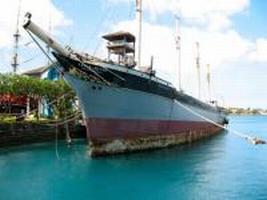 According to a saying often attributed to Mark Twain, “History may not repeat itself. But it often rhymes.” This came to mind recently when posting about the sad state of the windjammer Falls of Clyde, which recently nearly sank at the dock in Hawaii. In addition being the last surviving iron-hulled, four-masted full-rigged ship, the Falls of Clyde is also the only remaining sail-driven oil tanker.
According to a saying often attributed to Mark Twain, “History may not repeat itself. But it often rhymes.” This came to mind recently when posting about the sad state of the windjammer Falls of Clyde, which recently nearly sank at the dock in Hawaii. In addition being the last surviving iron-hulled, four-masted full-rigged ship, the Falls of Clyde is also the only remaining sail-driven oil tanker.
After an almost 30-year career carrying general and bulk cargos around the world, in 1907, the Falls of Clyde was converted into a tanker by Standard Oil, one of the firm’s 16 sail driven tankers. The Falls of Clyde would operate as a tanker carrying oil to Hawaii and molasses to California for another twenty years until 1927.
Why a sail-powered tanker? The economics made sense. Sailing ships cost less to operate than motor ships of the day.
 What does this have to do with history rhyming? Last September, we posted about the installation and testing of two rotor sails on the 110,000 DWT Long Range 2 product tanker, Maersk Pelican. The 30 meter tall and 5 meter in diameter rotors are the world’s largest rotor sails. They are a modern version of the Flettner rotor developed in the 1920s. If all goes well, the rotor sails are expected save between 7% and 10% on fuel costs.
What does this have to do with history rhyming? Last September, we posted about the installation and testing of two rotor sails on the 110,000 DWT Long Range 2 product tanker, Maersk Pelican. The 30 meter tall and 5 meter in diameter rotors are the world’s largest rotor sails. They are a modern version of the Flettner rotor developed in the 1920s. If all goes well, the rotor sails are expected save between 7% and 10% on fuel costs.
At first glance, the rotor sails hardly seem comparable to the spread of sails on the windjammer Falls of Clyde. Then again, the Falls of Clyde carried a cargo of oil of around 2,500 tons, whereas the Maersk Pelican’s cargo is 40 times larger. If the rotor sail tests are successful, the potential application is significant. Maersk alone has 80 tankers in service.
Rotor sails may or may not be the best technology for sail assisted tankers. Time and testing will tell the tale. Nevertheless, it does make sense to use the energy of the wind to save energy and reduced the carbon footprint of ships, even those carrying oil. Perhaps, especially those carrying oil.
In the best of all worlds, the Falls of Clyde, the last sailing tanker, will survive and be restored to last long enough to see a new generation of tankers propelled, at least partially by the wind.

Maersk’s Pelican is Very encouraging, real time testing of cantilevered rotary sails in the harsh marine environment’s: pitch and roll, weather, and salt water…
PSE&G had experimented with land based Madras rotors in Burlington, NJ, 1933, the depression years.
Do you know how or when they’ll be checking the savings in fuel?
Also, with differing weather and wave conditions, can’t fuel usage vary by up to 10% on each voyage? Will they be able to really see how much fuel was saved by using the rotors?
They started testing in September so they don’t have much data yet. They also have several sister ships to the Maersk Pelican that they can compare consumption on similar routes and weather conditions.
I just came across your post Rick, we will be posting results as they come in from all of the wind propulsion systems being currently tested, as those become available. Rotors, hard and soft sail, suction wings, kites, turbines etc. http://www.wind-ship.og